Pan Seared Salmon
Pan Seared Salmon is the ultimate way to enjoy this popular fish, just like they make it at the restaurant, with a golden crispy skin and a moist interior cooked to your preferred doneness. It’s very easy to make crispy salmon at home, in just 10 minutes! Here are all my essential tips.
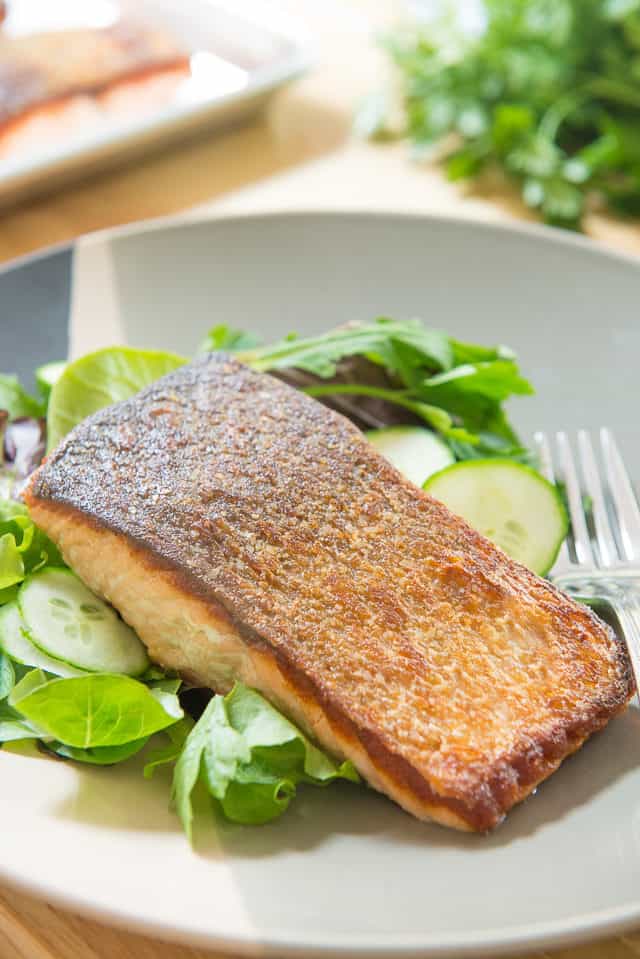
A moist, juicy piece of salmon with a robustly crispy skin is like icing on a cake. It’s truly the perfect contrast to a big fat piece of tender salmon.
The first time I tried salmon like this was at a restaurant many years ago, and I remember thinking, is it okay to eat the skin? I grew up eating salmon, but we always scraped the fish from the skin, then threw the skin in the trash.
But the moment I dug in and crunched down on the most wonderfully crispy shard of savoriness, I became hooked forever.
I’m going to show you how to get super crispy skin with perfectly cooked salmon in your own kitchen, and it’s really so much easier than you could imagine. The skin is robustly crunchy, even crispier than a potato chip!
While my quickest and easiest salmon recipe is this Baked Salmon, this crispy salmon only takes a little bit more effort and you get to enjoy that crunchy skin. The presentation is also very impressive.
Tips for Best Results
De-scale the skin – I’ll show you below how to remove the scales from the skin before cooking, in case the fishmonger didn’t do it thoroughly. These scales are like little plastic sequins in texture, so you definitely don’t want them ruining your eating experience!
Cook almost entirely on the skin – Another thing you’ll want to do that you’re likely not used to is to cook the salmon almost entirely on the skin side. This ensures maximum crispiness!
Dry the skin thoroughly – It is a rule in cooking that before browning can happen, all moisture must be cooked off. So dry the exterior thoroughly with a paper towel before cooking.
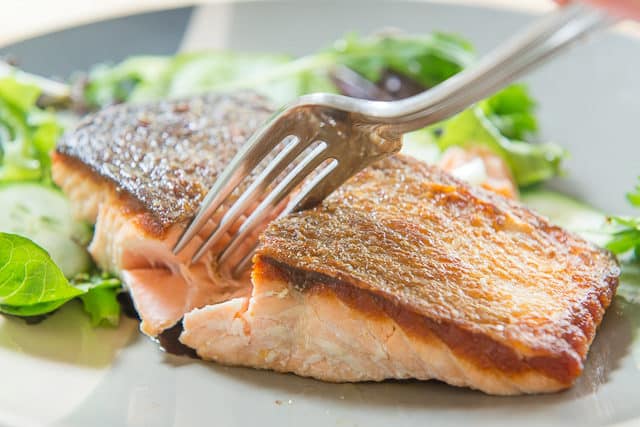
This is a healthy meal and great choice for preparing this wonderful fish!
What Kind of Salmon to Use
This recipe will work with any type of salmon, though cooking time will vary depending on kind and thickness. This is why it’s recommended that you use a thermometer when cooking meat and fish, to ensure that you get your desired doneness.
As a general rule, wild salmon tends to have more flavor but is also more lean and therefore less forgiving of overcooking. Farmed salmon tends to be fattier, but has an inferior flavor to wild. The only way to learn your preference is to give them all a try at some point and see what you like best.
My ultimate recommendation is Wild Alaskan King Salmon, as it has the best of both worlds with delicious flavor AND tenderness, but it is quite expensive. My second choice is farmed Atlantic salmon.
Ask for Center-Cut Fillets
When you’re purchasing your salmon at the grocery store, ask the fishmonger if he will give you center cut pieces. These will be more even in thickness, and cook more consistently.
Step by Step Overview:
First we need to make sure the skin is ready for searing and remove the scales. Oftentimes the fishmonger will de-scale the fish before filleting (mine does), but they often miss spots.
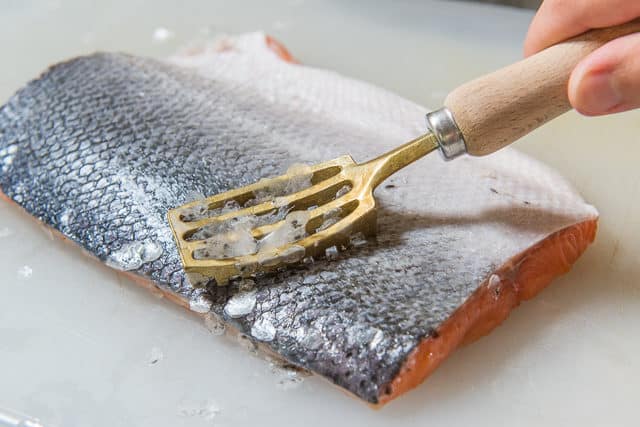
We eat salmon every week, so I bought a dedicated fish scaler, but you can also use a sharp chef’s knife to scrape off the scales…just beware that they will fly all over the place, so wear an apron.
After a few scrapes, voila, no more scales. You can tell they’re gone because the skin has a netting pattern to it:
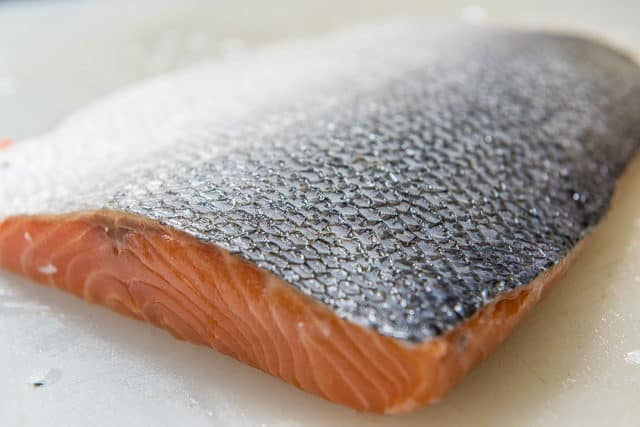
If needed, give the fish a quick rinse to remove the scales, or just brush them off.
Regardless of whether or not you rinse the fish, dry the exterior very well with paper towels. Water is the enemy of a good crispy sear.
Next, start preheating a skillet for searing the salmon.
What kind of skillet to use
For the best sear, I recommend an uncoated stainless steel pan. A well-seasoned cast iron skillet would be a close second.
Some people like to use a Teflon-style nonstick pan for searing fish, but I don’t. You just don’t get the same sear, and you’re not supposed to use this high of heat for those pans.
If the pan is hot enough, the fish won’t stick anyway. Literally I can pick the entire filet up with a pair of tongs because it’s so un-stuck to the pan.
Also, select a pan that’s fairly close in size to the piece of fish, then preheat for about 3-5 minutes (3 minutes for gas stoves, 5 for electric).
Once the pan is pre-heated and you’re ready to cook, dab the exterior one last time for any excess moisture on the outside:
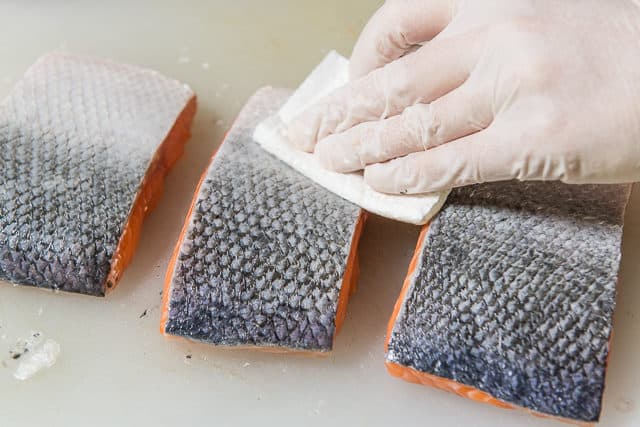
Then, season the fish skin with a good pinch of kosher salt at the last moment, right before you add it to the pan.
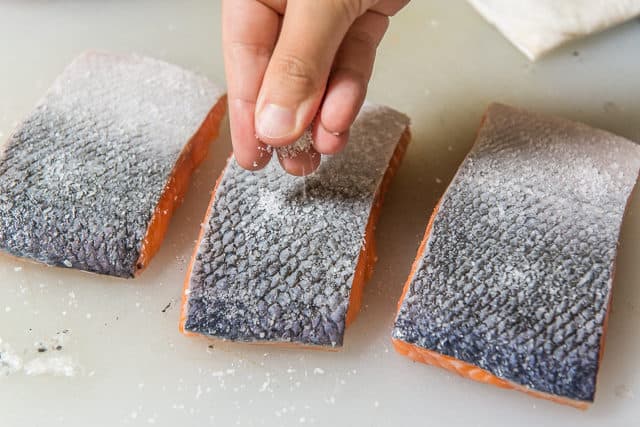
Side note: I don’t recommend black pepper on the skin, or spices like garlic powder or onion powder, as they will burn.
The reason you want to season with salt *right* before searing is that salt pulls moisture out of the fish skin and makes it wet again, preventing an optimal sear.
Time to Cook!
Add oil to coat the bottom of the skillet, and note that it should be shimmering, but not smoking violently. If it’s smoking like crazy, turn the heat down slightly.
What Kind of Oil to Use
Olive oil does not have a high enough smoke point for pan-seared salmon, because we have the skillet pretty hot, preheated over medium heat. I recommend using ghee, avocado oil, or other higher smoke point oils.
Take your piece of fish and test it by touching the very end of it to the pan. If it makes a hissing sizzling noise, that means the pan is sufficiently hot.
Go ahead and lay the fish down in the hot pan on the salmon skin side, always away from you so the hot oil doesn’t splash. (And if the fish doesn’t sizzle, your pan isn’t hot enough, so heat longer).
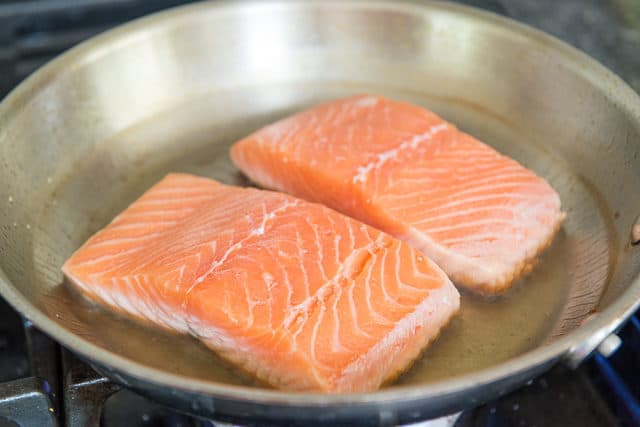
Here’s the secret: Let the fish cook for 90% of the time on the skin side. This thoroughly crisps the skin, and also results in a gentler cooking for the flesh side of the salmon.
How Long to Sear Salmon: The salmon I get is usually about an inch thick, so I cook it for 5 minutes on the skin side, until it’s golden brown and crispy. Time will vary depending on the thickness of the fillets, so always use a meat thermometer to check.
Once the salmon is cooked most of the way (you can see this below), I flip the individual fillets over to give them a brief “kiss” on the other side, cooking for about 15-30 seconds:
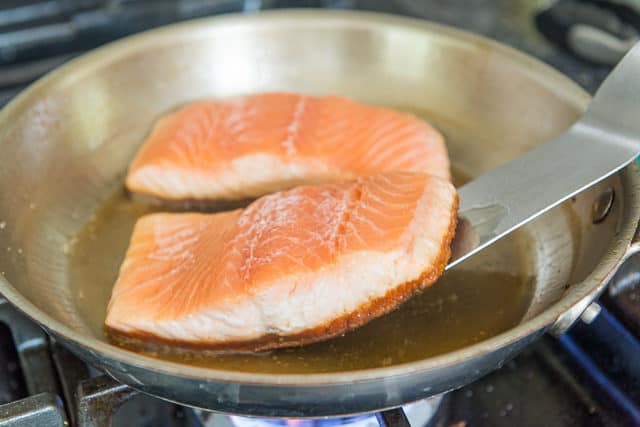
If the pan was hot enough when adding the fish, you should have no issue getting the salmon off the skillet, but I like to use this razor thin turner to get under it and keep the salmon held together in a nice piece. A fish spatula would also work well.
When removing the fish from the skillet, plate it with the skin side up, so the skin retains its crispiness and keeps from getting soggy. Plus, that way you get to admire that perfect golden crust!
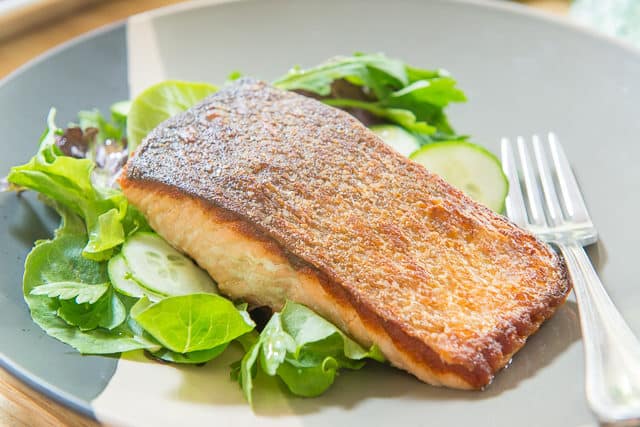
Here’s a look at the inside, which is moist and glistening. I like salmon at medium, so with an internal temperature of about 125F. This doneness gives you tender salmon fillets that flake nicely, but are still slightly pink.
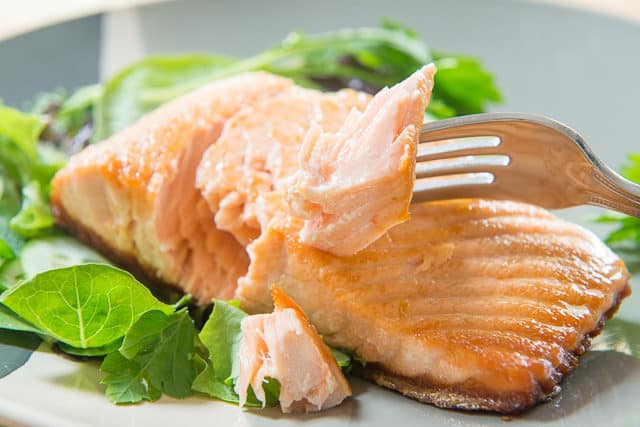
If you want the fish fully cooked, 140 degrees F is sufficient.
How to Serve
Because this Pan Seared Salmon only has salt, you may wish to serve it with lemon slices, a sprinkle of fresh herbs, or a sauce. I love pairing it with Romesco, Basil Pesto, or Chimichurri. A classic Tartar Sauce also always goes well with seafood.
For side dishes, any type of salad like Carrot Raisin Salad, Tabbouleh, or White Bean Salad will work nicely. You can also try heartier sides like Roasted Acorn Squash, Cauliflower Mashed Potatoes, or Crispy Smashed Potatoes.
Seared Scallops are another one of my favorite seafoods to make at home, as it’s crazy easy and much cheaper than the restaurant.
Salmon Salad and Smoked Salmon Deviled Eggs are also great salmon dishes that I recommend. Enjoy!
Recipe Tips and FAQ
Store in an airtight container for up to 3 days.
Yes, store in an airtight container for up to 2 months. For best results, thaw in the fridge overnight before reheating.
The best way to reheat is to crisp the skin in the skillet much like how you cooked it, skin-side down, then give it a flip at the end to warm the top. You may also use the microwave, but I recommend cooking gently at no more than 50% power in 30 second intervals until it’s warm to the touch, as it’s very easy to overheat the fish in the microwave.
No, always thaw the fish first. You can thaw quickly in cold water, which takes about 15 minutes. Make sure to dry it very thoroughly before cooking.
Did you enjoy the recipe? Please leave a 5-star rating in the recipe card below and/or a review in the comments section further down the page. Or, follow me on Facebook, Instagram or Pinterest!
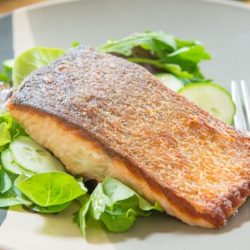
Pan Seared Salmon with Crispy Skin
Ingredients
- 2 salmon fillets skin-on, descaled, and patted dry with paper towels
- avocado oil* or ghee, for searing
- salt
Instructions
- Preheat a skillet over medium heat for 3-5 minutes (3 minutes for gas stoves, 5 for electric).
- Add enough oil to coat the bottom of the pan, about 1-2 tbsp. The oil should shimmer.
- Season the skin of the fish generously with salt, then test your piece of fish by touching the very end of it to the pan. If it makes a hissing sizzling noise, that means the pan is sufficiently hot. Go ahead and lay the fish down in the pan, always away from you so the oil doesn’t splash.
- Let the salmon cook for 90% of the time on the skin side. The salmon I get is usually about an inch thick, so I cook it for 5 minutes on the skin side.
- Season the top of the fish with salt, then flip it over to cook for 15-30 seconds on the other side. Serve on the plate skin side up, and enjoy!
Notes
Nutrition
Nutrition is estimated using a food database and is only intended to be used as a guideline for informational purposes.
Post updated with new photos, writing, and more tips in August 2018. Originally published August 2012. This post contains an affiliate link.

124 Comments on “Pan Seared Salmon”
I’ve made this recipe SO MANY TIMES since I found it. I absolutely LOVE IT!! I can never get the skin as great as your picture…but I won’t give up. I use avocado oil. Maybe I have the stove too hot so the skin burns and the salmon isn’t finished. I still love it. Thank you so much!
Made this tonight and you have ruined me for ordering salmon in a restaurant. My husband and I savored every bite. Simple preparation made the fish the star of the show. Serving it skin side up kept it perfectly crispy but the flesh was oh, so moist. Kudos to you. Superb in it’s simplicity and taste. BTW, used my cast iron skillet and it was great. Preheated it as you instructed and allowed the oil to shimmer. Fish sizzles the moment it hits that shimmering ghee. Magical.
Delish! Thanks for the thorough instructions and terrific recipe. Hubby looked at me suspiciously when I said “you should taste the skin.” One bite and he was a believer. We’re so happy to have a new and very tasty way of enjoying our salmon.
Very good recipe!!
Hi! I tried this recipe tonight! It was delicious! Some of the skin stuck to pan, sadly! I used sunflower oil, any tips for next week when I make it?
Loved this recipe. I followed all the steps and the salmon came out so delicious.
So delicious! The texture of the flesh is just right, not flaky; the skin is very crispy. Thanks for the recipe!
Tried your Crispy skin salmon. Came out good. You need to research your smoke points a little better. Extra virgin olive oil 1st cold pressed has a smoke point between 375-400 F. It is the most healthy oil you can use and nothing you fry, including fried chicken needs to be over 375 F. I sprinkled salt and pepper on the flesh side, squeezed fresh lemon juice on and poured unsalted clarified garlic butter over the fillets.